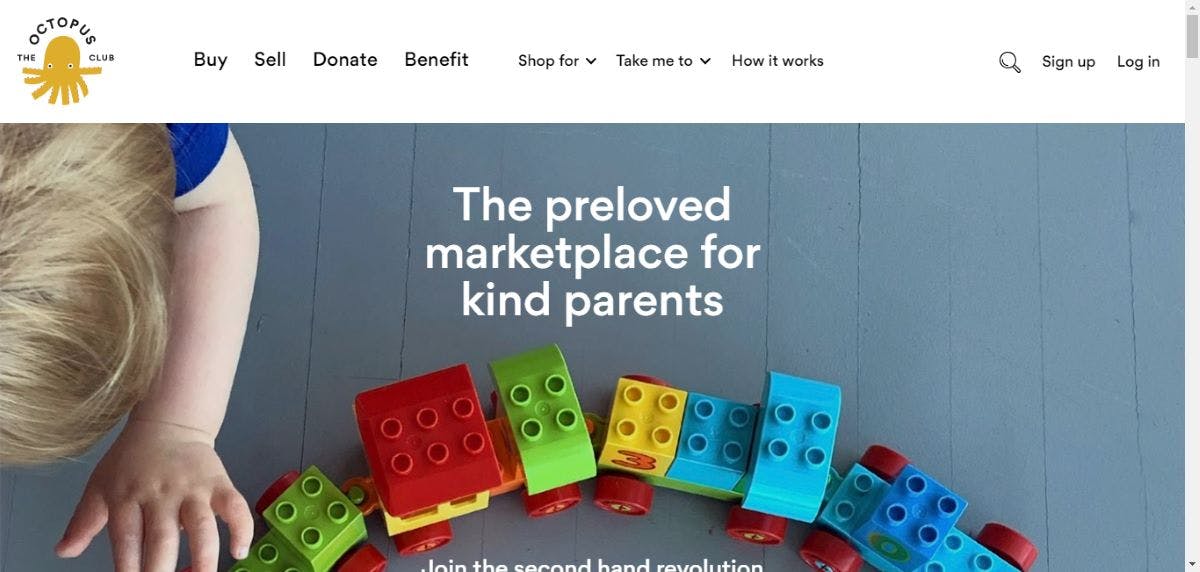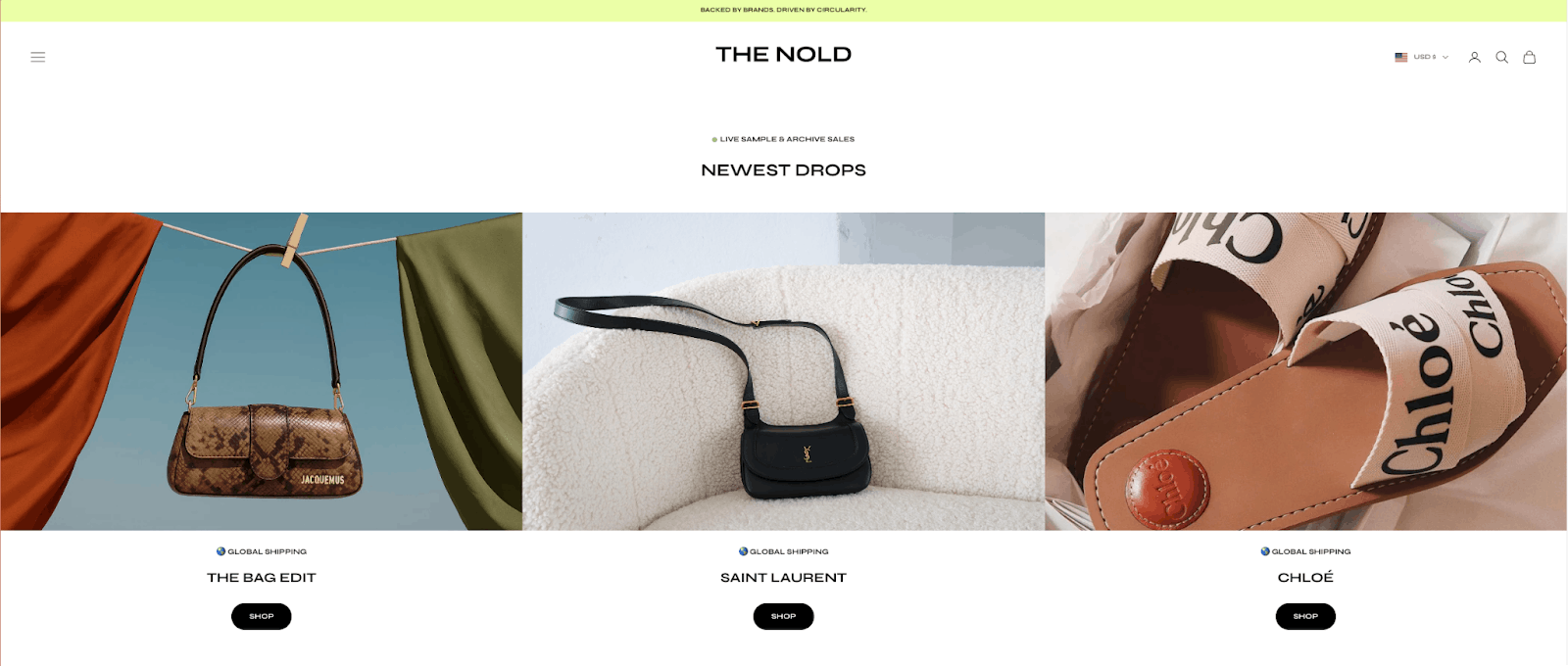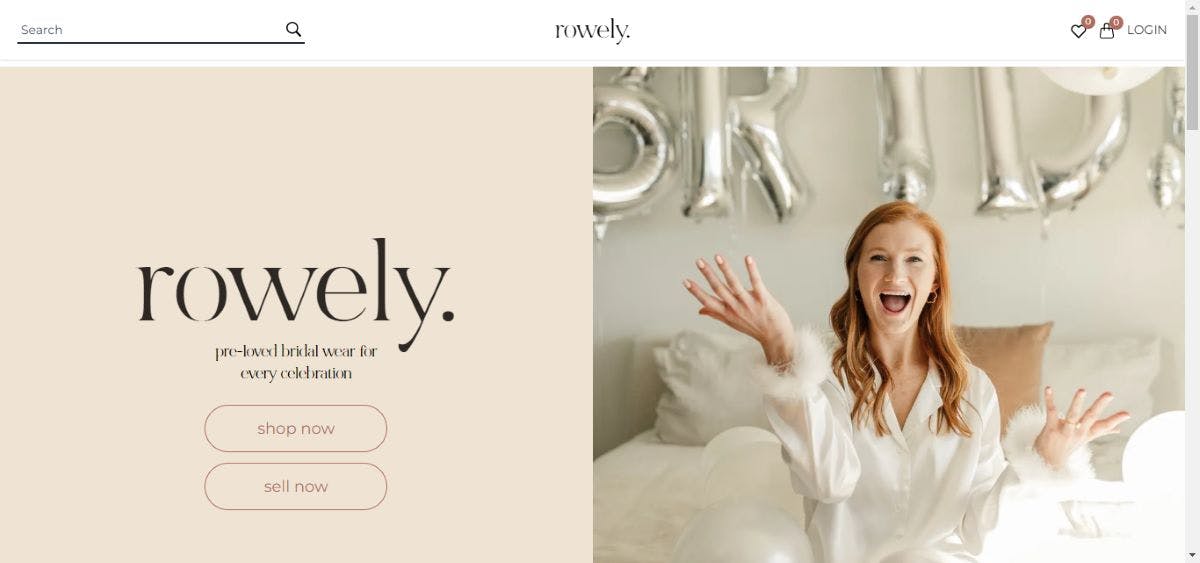How to build a website like Vinted
Vinted is an online marketplace for buying, selling, and swapping second-hand clothing and accessories. This guide explores how to build your own marketplace like Vinted, from designing and building your website to scaling your business.
Founded in 2008 by Milda Midkute and Justas Janauskas, Vinted has come a long way from its origins as a forum-like website for peer-to-peer clothes trading.
Marketplace businesses like Vinted scale so well because they don’t need to own the inventory. The clothes sold on Vinted are owned by their millions of sellers, not the company. This makes it possible to build a big business without a heavy initial investment.
However, it takes a lot of work to build a successful marketplace. You’ll need a sound strategy, an understanding of users’ needs on the seller and buyer side, and a willingness to learn and iterate as you go.
This guide breaks down how platforms like Vinted operate, what makes them thrive, and what it takes to create a successful alternative. We’ll walk you through the business model and give step-by-step guidance for launching a resale marketplace. We’ll also share real-life examples of websites like Vinted and tips for building your own marketplace from idea to launch.
Vinted is an online marketplace that allows people to buy, sell, and swap second-hand clothing and accessories. It’s a great way to earn money by selling clothes you no longer love or save money by buying gently used items at a fraction of retail prices.
To sell on Vinted, members first need to create an account. After that, sellers can list clothing items in several categories, such as men’s, women’s, and children’s clothing. The sellers must add photos of the listed items and write detailed descriptions. The listings will then show up on other users’ feeds, who can save apparel to their favorites and follow sellers.
Buyers can search and filter the large selection of clothing items from sellers. When a buyer finds what they like, they are asked to create an account if they don’t already have one. Then, they can either purchase the item for the quoted price or make an offer below the asking price. The seller then has the option to accept the offer, reject it, or give a counteroffer. All of the communication involved happens on the platform through its messaging system.
Once a sale is made, Vinted will generate a prepaid shipping label for the seller, who must pack the selected items and ship them off with the label on the package. Payment is handled securely through the website, and buyers handle shipping costs. Once the buyer receives the item and confirms its condition, the seller receives the payment. The buyer is also asked to review the seller.
Vinted is an excellent example of a community-driven marketplace. Many of its members use Vinted to both buy and sell clothing, and this sense of community and trust between members is critical to its success. To that end, Vinted incorporates some social networking features into its platform: users can create profiles, connect with other members, follow sellers, and like, comment on, and share listings.
Originally built to help one co-founder get rid of excess clothes, the Lithuanian-based company now serves over 75 million users in 22 countries from its five offices in Vilnius, Berlin, Hamburg, Prague, Amsterdam, and Utrecht. In May 2025, Vinted became the leading clothing retailer in France—outranking Amazon and the local marketplace Kiabi.
It’s no wonder Vinted’s most recent valuation reached €5 billion in 2024, following a 36% increase in revenue.
The success of Vinted and other famous online marketplaces like Airbnb, Etsy, and Fiverr has shown that the marketplace model is scalable and can be applied to almost any industry. The global sharing economy is growing fast: currently valued at $336 billion in 2024, it’s expected to reach $1.4 trillion by 2030.
Vinted’s success lies in its simplicity, accessibility, and mobile-first design. The platform offers a wide range of second-hand items and streamlines the resale experience with features like free shipping, discounts, and buyer incentives. Buyers can search for specific items, make offers, and negotiate directly with sellers, all within the app.
What truly sets Vinted apart is its user-first model. The platform doesn’t charge sellers to list items or take a cut of their earnings. Instead, it monetizes through buyer-side fees and optional services. This approach has helped Vinted grow organically and attract millions of sellers who want to quickly and easily declutter their closets.
Several key elements have contributed to Vinted’s continued growth:
- Zero listing fees for sellers: Sellers keep 100% of the sale price, which makes it appealing to list items.
- Buyer protection fee model: Monetization is shifted to the demand side via service fees to create a low-friction experience for sellers.
- Built-in shipping and prepaid label generation: Logistics are streamlined to make it easier for buyers to complete their purchases.
- Strong focus on trust: Features like user reviews, in-app messaging, and dispute resolution systems build confidence between buyers and sellers.
- Mobile-first UX and gamified listing flow: The app encourages frequent uploads with intuitive design and motivational prompts.
- Positioning around sustainability and conscious consumption: Vinted taps into growing consumer demand for environmentally responsible fashion, a global market expected to reach $39.7 billion by 2031.
Vinted’s combination of a seller-friendly business model and values-driven branding has made it one of the most successful resale marketplaces in the world.
Vinted uses a combination of several marketplace business models to stay profitable.
Basic use of the website is free, and Vinted doesn’t charge any commission from its sellers. However, customers must pay a commission on every purchase, which Vinted calls a buyer protection fee. In the United States, this buyer protection fee is fixed at $0.70 on all offerings, and an additional 5% fee is paid on the total sale price. It protects buyers from things like damaged items and fraud.
Vinted also uses featured listings, ads through spotlights, and bumped offers as additional revenue streams. These deals help sellers improve the visibility of their items, which will appear on users’ feeds for a few days for an extra fee.
Lastly, third-party ads also add to the revenue stream of Vinted. Advertisers are offered a self-service platform where they can create campaigns and register subscribers.
Below are some online marketplaces similar to Vinted that can be considered competitors:
- eBay: eBay is an e-commerce platform and consumer-to-consumer (C2C) marketplace where users can buy or sell almost any item, like clothes, electronics, and more. Unlike Vinted, it is not solely a consumer-to-consumer platform and also supports business-to-consumer (B2C) sales.
- Poshmark: Like Vinted, Poshmark is a community-driven marketplace for buying and selling fashion online. It was created by Manish Chandra and has features for negotiating prices and creating a virtual closet.
- Grailed: Grailed is another peer-to-peer marketplace for clothing. The platform stands out for its focus on selling only luxury brands.
- ThredUp: ThredUp is an online thrift store for second-hand clothes, similar to Vinted. It also tries to focus on well-known brands.
- Depop: Simon Beckerman founded Depop as an incubator project in Italy. The platform is becoming more popular in countries like the UK and the United States because it heavily focuses on its social media features, like building a community of followers who engage with sellers’ items.
Creating a website like Vinted doesn’t mean cloning every feature from day one. Instead, build a platform that solves a specific problem for a specific group of people, then grow from there.
If you're still shaping your idea, our guide on planning your marketplace can help you understand what makes marketplace businesses unique and what to consider before building one.
Now, let’s go over the key steps for building a thriving fashion resale marketplace, from idea to launch and beyond:
- Choose your niche
- Validate your idea
- Choose the right business model
- Build your MVP (Minimum Viable Platform)
- Onboard and grow your supply
- Launch and iterate
- Scale your marketplace
Every successful marketplace starts with a well-defined niche. Vinted started as a local site for women in Lithuania to swap second-hand clothing. Now, it spans millions of users and dozens of categories, including menswear, beauty products, and even home goods in some regions.
Starting with a narrow focus makes it easier to connect supply and demand, build trust, and more effectively solve the chicken and egg problem.
Research your target audience and competitors. What features does Vinted offer, and which ones do users value most? What needs remain unmet? Look for gaps in product types, geographies, or user experiences. You might focus on a specific clothing category, a regional market, or a particular kind of shopper or seller.
This early research helps you shape a strong, differentiated offering. If you’re still unsure how to find your niche, check out our guide on coming up with a great marketplace idea.
Before investing time or money into development, validate that people want what you plan to build. A strong value proposition is at the heart of this process. It should clearly explain how your marketplace solves a real problem for both sellers and buyers.
Start by talking to potential users. What are their current frustrations? Would your solution be a better alternative? Use interviews, surveys, or waitlists to gather insights. Then refine your idea and test early interest with landing pages or concierge MVPs.
For more tips, read our guide on how to validate your marketplace idea early.
Your business model shapes everything from user experience to long-term growth. Most marketplaces, including Vinted, start with a commission model, but there are many options to choose from:
- Subscriptions
- Listing fees
- Freemium tiers
- Value-added services like shipping or insurance
The best business model depends on your niche, user behavior, and the kind of value your platform provides. Early on, low-friction options like commission or freemium can help attract supply and demand. As your marketplace matures, your model should evolve with it.
Read our complete guide to the most common marketplace business models to figure out which one works best for you.
With your niche, audience, and business model defined, it’s time to launch your first version: a Minimum Viable Platform (MVP).
When building, always focus on your marketplace’s core mission: enabling buyers and sellers to connect and complete a sale. You can differentiate your business from others like Vinted by tailoring your product to your niche. For instance, that could mean curating a more specialized selection, offering faster customer support, or simplifying logistics.
Just remember: you don’t need to launch with every feature. Start lean, then evolve based on user feedback.
There are many options to consider when building a Vinted-style website. Finding the right marketplace development approach for you will depend on:
- The features you believe your marketplace needs
- The technical skills of your team
- The time and money you’re ready to spend on building your platform
However, in most cases, you should choose a solution that helps you launch fast and start learning from real users.
Here are the most common methods of building an online marketplace.
Build a marketplace entirely from scratch
This will entail creating the code for all the features your marketplace needs. You’ll also need to choose your tech stack and set up the marketplace app framework and database.
This can be incredibly time-consuming and not worth it overall. Whether you’re a developer yourself or employing an IT team, the bulk of your budget will go into coding, debugging, and managing marketplace basics. So make sure you’re ready to take on all these duties before using this method.
Build a marketplace with WordPress
You can also use WordPress to build your marketplace with plugins and themes that can be bought separately and installed on top of WordPress. These will allow you to modify the basic functionality of WordPress to support your e-commerce implementations.
Though faster and cheaper than building from scratch, this can still take a lot of time. Meanwhile, the result might not be as smooth and reliable as you hoped.
Build a marketplace on top of open-source software
Use an open-source solution that you can download, modify, and host on your own servers.
This method costs less than building from scratch, but you’ll still need considerable developer knowledge to build and maintain it. The developer experience can leave a lot to be desired.
Built with a combination of no-code tools
The no-code tools you’re already familiar with can help you create very specific functionality and the exact layout you want for your marketplace website. For example, Webflow, Airtable, and Zapier can come together to form a solid tech stack for building an online marketplace.
The downside is that you will need to have a good understanding of marketplace functionality and the tools needed to achieve it as early as possible. Learning to use all the no-code tools can also take a considerable amount of time.
Build with a dedicated marketplace SaaS tool
A software-as-a-service tool can make building your marketplace platform a breeze and ensure a quick launch. Hosting, payments, and essential features like listings and messaging are also included with SaaS no-code tools for marketplaces.
Unlike WordPress-based solutions that often break at scale or require constant developer intervention, purpose-built SaaS platforms are more stable.
For instance, Sharetribe is designed to launch a marketplace like Vinted quickly, with the ability to scale easily later. You can get started for free with a 14-day trial and build your marketplace. Once you’re ready to invite users to your platform, you can subscribe and launch—even as fast as in one day.
The biggest drawback of most no-code marketplace builders is that they’ll never have all the unique features your idea needs. However, Sharetribe is infinitely expandable. You can build custom features on top of the no-code essentials or custom-develop your entire front-end while the backend—user management, transactions, payments, hosting, security—is handled for you. This approach typically saves up to 90% in time and cost compared to building from scratch.
With this approach, you’ll need some developer support, either in-house or from Sharetribe’s partner network. For most marketplace founders, this strikes the right balance between speed, scalability, and control, so you can launch fast and start learning from real users.
A marketplace can’t function without supply. Once your MVP is live, you need to attract and activate your first sellers.
Focus on personal outreach and building relationships, especially if you’re operating in a niche or local market. You should also make the listing process as simple as possible and support early users through onboarding. This might include:
- Helping them create their first listings
- Offering photo or pricing tips
- Walking them through the platform via a quick call or tutorial
For more information, read our detailed guides on building supply before you launch and growing your initial marketplace supply.
Once you have the initial sellers in place, it’s time to bring in just enough buyers so that the supply and demand are in balance. Resist the temptation to try to scale your user base too soon. It’s much better to offer a great experience for a handful of early users than a mediocre one for many.
The first version of your marketplace is just the beginning. Once live, observe how users interact with your platform, and be ready to adjust quickly.
Track key marketplace metrics to measure how people are using your platform. In addition to this quantitative data, talk to your early adopters to uncover what’s working and what’s not.
This is also the stage where you test for problem-solution fit: the point at which users consistently turn to your platform to solve a real need. Reaching this milestone is critical: it means your marketplace delivers enough value to keep users coming back.
It also means you’re ready to start working towards the next milestone: product-market fit. At product-market fit, your marketplace shows it has the potential to become a profitable business.
Without reaching these milestones, no amount of growth tactics will create sustainable traction.
A strong sense of community can become your biggest advantage as you work towards problem-solution fit and product-market fit. At this stage, look for ways to foster connection and loyalty as you grow. Here are some ideas for how to do this:
- Start a private Facebook group or Discord server
- Highlight top sellers in your email newsletter
- Run small giveaways
- Set up a referral program
- Thank your early users personally
Once you’ve validated your model and found early traction, it’s time to grow.
Start by identifying the most effective channels to reach your target audience. This might include SEO, paid ads, partnerships, or even local community events. What worked at launch may not scale, so experiment, test, and double down on what delivers results.
Scaling also means building systems: automated onboarding, retention strategies, and sustainable supply-demand growth. Check out our guide on scaling your marketplace for more practical tactics for this stage.
Sharetribe helps founders create marketplaces like Vinted while still meeting their unique business needs. Below are a few marketplaces similar to Vinted that were built on Sharetribe.
Having a baby is expensive. You have to buy a crib, baby clothes, toys, and maternity items. The Octopus Club is a peer-to-peer platform that allows people to buy and sell affordable second-hand baby items.

The Nold is a fashion resale marketplace where both individuals and brands can list their items. With inventory is either sourced directly from brands or authenticated, The Nold distinguishes itself from competitors with a focus on quality, trust, and exclusivity.

Rowely is another consumer-to-consumer marketplace inspired by a common problem. Seeing how hard it is to get affordable, high-quality wedding essentials for the big day, Rowely partnered with Sharetribe to give users a platform where they can find stunning pre-loved wedding pieces for reasonable prices.

If you’re ready to dive deeper, check out our complete guide to building an online marketplace, which is packed with practical, founder-tested advice. We also have a more specific guide on building a second-hand clothing marketplace. Both give a ton of expert advice for marketplace entrepreneurs that you can apply regardless of how you choose to build your website.
With Sharetribe, you can launch a second-hand marketplace quickly, even without technical experience. Our platform gives you everything you need to get started: listings, messaging, payments, reviews, shipping integrations, and more. That way, you can focus on building your supply, attracting early users, and learning what drives engagement, rather than spending months on infrastructure.
If you want to build a more customized marketplace, you can add new features or redesign your front end as you grow using Sharetribe’s API and developer tools. Or team up with one of our vetted Sharetribe Experts, who are experienced developers who can help you build exactly what you need, faster.
Start a free trial of Sharetribe today and launch your Vinted-style marketplace in days, not months.
We wish you all the best with your marketplace!
The cost varies widely depending on your approach. Building from scratch with a development team can cost $50,000 to $200,000 or more. Using a no-code or API-based marketplace builder like Sharetribe is significantly more affordable because you can launch for a few hundred dollars and scale up as you grow.
At a minimum, you’ll probably need:
- User profiles
- Listings with photos and descriptions
- Search and filtering
- Online payments
- Messaging between users
- Reviews and ratings
- Admin tools for moderation and management
No, not necessarily. But offering built-in shipping is a major convenience, especially for second-hand product marketplaces. It reduces friction for sellers and helps transactions feel more secure.
Platforms like Vinted offer prepaid shipping labels, which you can replicate using tools like Sharetribe’s Stripe integration and an integration to a third-party shipping platform like Shippo, Stamps.com, ShipStation, or Sendcloud.
The most common model is a buyer-side service fee, like Vinted uses. Other options include:
- Commission on sales
- Listing or promotion fees
- Subscriptions for sellers
- Value-added services like insurance or shipping
You can start with one model and expand as your platform grows.
The best platform depends on your goals, budget, and technical resources. Sharetribe is a strong choice if you want to launch quickly without coding and later customize using APIs. Unlike WordPress plugins or clone scripts, Sharetribe is more scalable, secure, and purpose-built for marketplaces.
Start your 14-day free trial
Create a marketplace today!
- Launch quickly, without coding
- Extend infinitely
- Scale to any size
No credit card required
